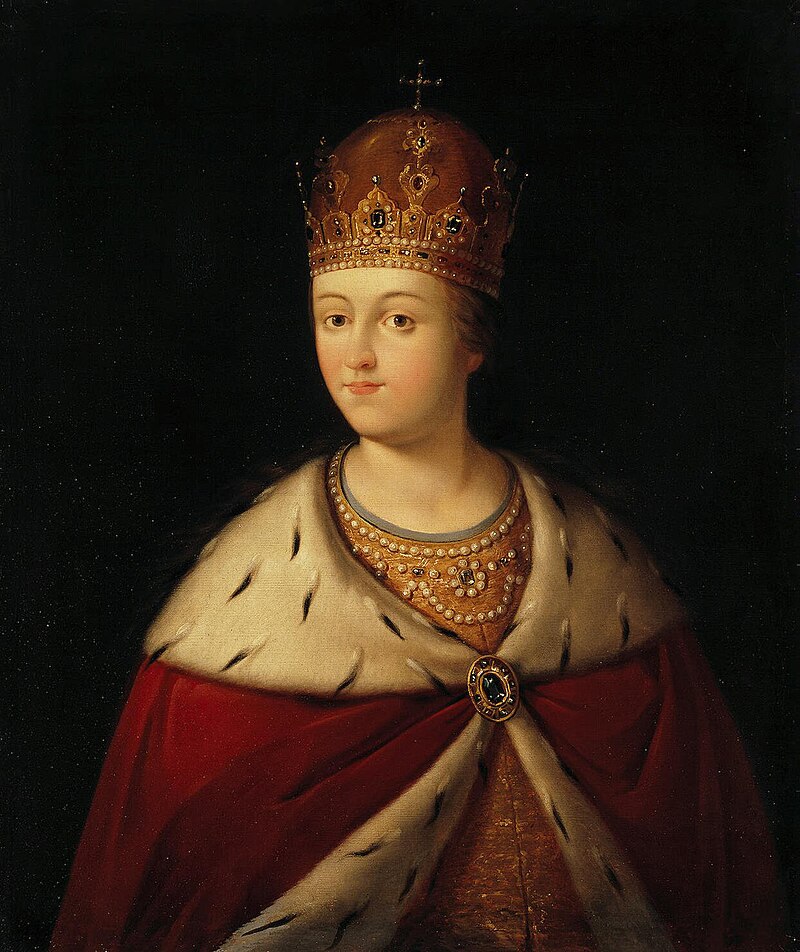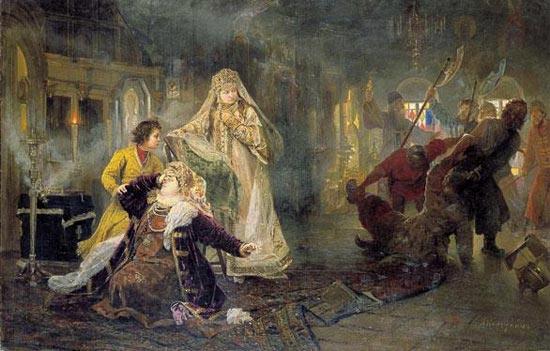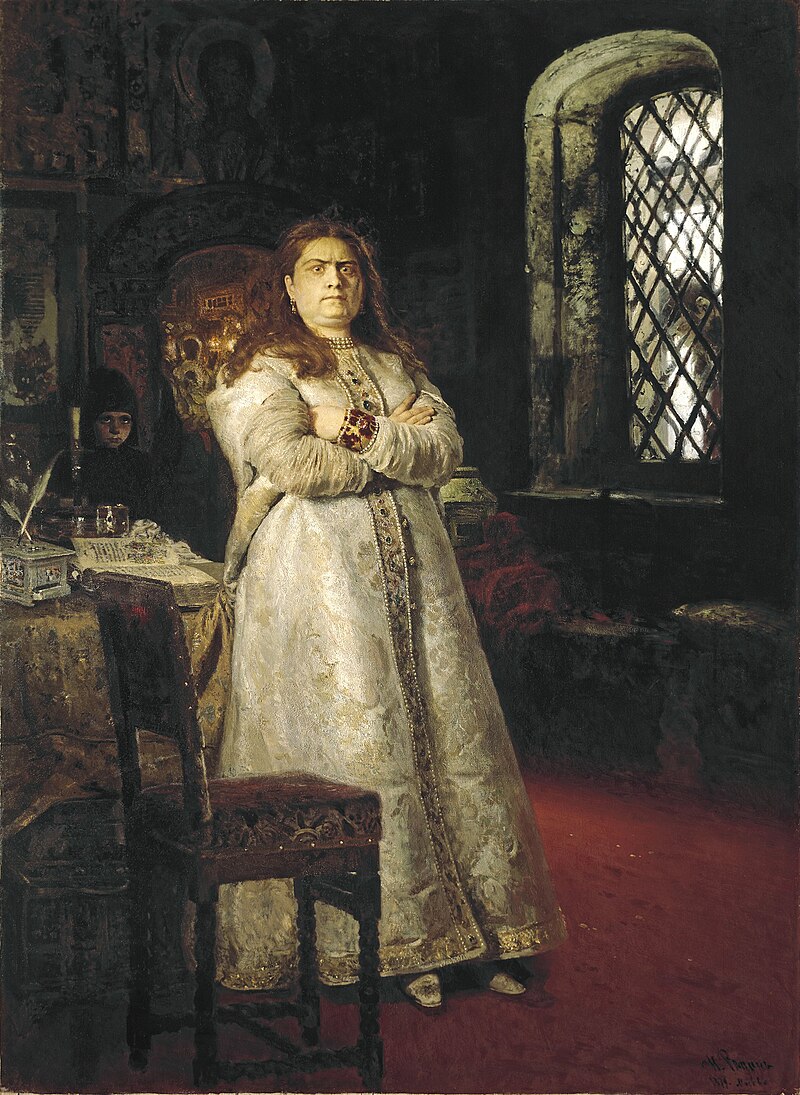by Susan Flantzer © Unofficial Royalty 2018

Tsarevna Sophia Alexeievna, Regent of Russia; Credit – Wikipedia
Regent of Russia for seven years during the early co-reign of her brother Ivan V and her half-brother Peter I (the Great), Tsarevna Sophia Alexeievna was the sixth of the thirteen children and the fourth (but the third surviving) of the eight daughters of Alexei I, Tsar of All Russia and his first wife Maria Ilyinichna Miloslavskaya. She was born on September 27, 1657, in Moscow.
Sophia had twelve siblings:
- Tsarevich Dmitri Alexeievich (1648–1649); died in infancy
- Tsarevna Yevdokia Alekseievna (1650–1712)
- Tsarevna Marfa Alexeievna (1652–1707)
- Tsarevich Alexei Alexeievich (1654–1670); died unmarried, age 15
- Tsarevna Anna Alexeievna (1655–1659); died in infancy
- Tsarevna Ekaterina Alexeievna (1658–1718)
- Tsarevna Maria Alexeievna (1660–1723)
- Feodor III, Tsar of All Russia (1661–1682); succeeded his father as Tsar of Russia; married (1) Agaphia Simeonovna Gruszewska, no surviving children (2) Marfa Matveievna Apraksina, no children
- Tsarevna Feodosia Alexeievna (1662–1713)
- Tsarevich Simeon Alexeievich (1665–1669); died in infancy
- Ivan V, Tsar of All Russia (1666–1696); was co-ruler along with his younger half-brother Peter I; married Praskovia Saltykova, had five daughters including Anna, Empress of All Russia
- Tsarevna Yevdokia Alexeievna (1669–1669)
Neither Sophia nor any of her sisters married. They grew up with their aunts in the terem, the separate living quarters occupied by royal and noble Russian women. They were prevented from socializing with men outside their immediate family and shielded from the public eye in closed carriages or heavily concealing clothing. However, it does seem that Sophia received an education from Simeon Polotsky who also taught her brothers and her father’s heirs Tsarevich Alexei and Tsarevich Feodor.
In 1669, 12-year-old Sophia’s mother Maria Ilyinichna Miloslavskaya died due to childbirth complications following the birth of her thirteenth child who also died. The death of Sophia’s brother the heir 15-year-old Tsarevich Alexei in January 1670, so soon after her mother’s death, was especially difficult for father Tsar Alexei because his only surviving sons were the future Tsars, Feodor III, who was disabled by an unknown disease which left him disfigured and partially paralyzed, and Ivan V, who had serious physical and mental disabilities.
Nineteen-year-old Natalya Kirillovna Naryshkina was picked as Tsar Alexei’s second wife. On February 1, 1671, the couple was married in Moscow. Alexei hoped his second marriage would give him a healthy son, and it did, Peter the Great.
Sophia had three half-siblings from her father’s second marriage to Natalya Kirillovna Naryshkina:
- Peter I (the Great), Emperor of All Russia (1672–1725), married (1) Eudoxia Feodorovna Lopukhina, had three sons, only Alexei Petrovich, Tsarevich of Russia survived (2) Martha Skavronskaya (later Catherine I, Empress of All Russia), had eleven children, only two daughters survived childhood Grand Duchess Anna Petrovna (mother of Peter III, Emperor of All Russia) and Elizabeth, Empress of All Russia
- Tsarevna Natalya Alexeievna (1673–1716), unmarried, a playwright and founder of the first public theater in Russia
- Tsarevna Fyodora Alexeievna (1674–1677)
On February 9, 1676, five years after marrying Natalya Kiillovna, Alexei I, Tsar of All Russia died of a heart attack at the age of 46. He was succeeded by 15-year-old Feodor III, his eldest surviving son from his first marriage. Even though Feodor was well educated and had a fine intellect, his debilitating physical condition prevented him from fully reigning. Throughout Feodor’s reign, the government was largely run by Artamon Sergeyevich Matveev, who had raised Natalya Kirillovna and had become a close friend of her husband Alexei. Feodor married twice but he had no surviving children and died on May 7, 1682, at the age of 20.
Feodor’s death triggered the Streltsy Uprising of 1682, a struggle for the succession between the families of the two wives of Alexei I. Alexei’s son by his first wife, Feodor III, left no surviving heir. Feodor was followed next in the line of succession by his only surviving full brother, the 15-year-old Ivan, who had serious physical and mental disabilities. The family of Natalya Kirillovna Naryshkina, instead wanted her ten-year-old son Peter to succeed. The Boyar Duma, a council of Russian nobles, chose Peter to become Tsar of All Russia with his mother as regent.
To protect the interests of her brother Ivan, Sophia led a rebellion of the Streltsy, an elite military corps, in April – May 1682. During the rebellion, some of Peter’s relatives and allies were murdered, including two of his maternal uncles and his father’s good friend Artamon Sergeyevich Matveev. The rebellion made it possible for Sophia, her maternal family the Miloslavskys, and their allies to insist that Peter and Ivan be proclaimed joint Tsars, with Ivan being the senior Tsar. Sophia acted as Regent during the minority of Ivan and Peter and ruled as an autocrat.

Streltsy Uprising of 1682 – Ivan Naryshkin, Natalya Kirillovna Naryshkina’s brother, is dragged out of the palace while Peter I consoles his mother and Sophia watches with satisfaction; Credit – Wikipedia
For the first time since Elena Vasilyevna Glinskaya ruled as Regent for her son Tsar Ivan IV (the Terrible) from 1533 – 1538, a woman was in charge of Russia. Prince Vasily Golitsyn was Sophia’s adviser and favorite, and possibly her lover. During her regency, Sophia continued the military reforms of her father Alexei I and her brother Feodor III. Golitsyn oversaw foreign policy and his most important accomplishments were the Eternal Peace Treaty of 1686 with Poland and the 1689 Treaty of Nerchinsk with China. However, the Russian defeat in the Crimean campaigns of 1687 and 1689 began to lead to Sophia’s downfall.
The military defeats meant that Peter I’s reputation increased. His political involvement grew and his popularity with the Russian people increased. Even the infirm Ivan V began to rebel against his sister Sophia. With Peter’s coming of age and his marriage, the possibility of Sophia’s dismissal as Regent seemed very real. Therefore, Sophia and her followers planned to assassinate Peter but he was told of the plot and escaped. Eventually, Sophia had no followers willing to take risks for her interests. She was arrested, forced to give up her position as a member of the royal family, and forced to withdraw to the Novodevichy Convent under guard.

Ilya Repin’s 1879 painting portrays Sophia after her fall from power, confined to a cell in the Novodevichy Convent; Credit – Wikipedia
During the Streltsy Uprising of 1698, the Streltsy secretly contacted Sophia and asked for her help. After Peter put down the rebellion, Sophia was forced to become a nun under the name of Susanna. She remained in the strictest seclusion with the other nuns allowed to see her only on Easter. Sophia Alexeievna died on July 14, 1704, at the age of 46, and was buried in the Smolensk Cathedral at the Novodevichy Convent in Moscow.

Smolensk Cathedral at Novodevichy Convent, burial place of Sophia Alexeevna; Photo Credit – By A.Savin (Wikimedia Commons · WikiPhotoSpace) – Own work, CC BY-SA 3.0, https://commons.wikimedia.org/w/index.php?curid=21361787
This article is the intellectual property of Unofficial Royalty and is NOT TO BE COPIED, EDITED, OR POSTED IN ANY FORM ON ANOTHER WEBSITE under any circumstances. It is permissible to use a link that directs to Unofficial Royalty.
Work Cited
- De.wikipedia.org. (2017). Sofia Alexejewna. [online] Available at: https://de.wikipedia.org/wiki/Sofia_Alexejewna [Accessed 16 Dec. 2017].
- En.wikipedia.org. (2017). Sophia Alekseyevna of Russia. [online] Available at: https://en.wikipedia.org/wiki/Sophia_Alekseyevna_of_Russia [Accessed 16 Dec. 2017].
- Lincoln, W. Bruce. (1981). The Romanovs: Autocrats of All the Russias. New York, NY.: Doubleday
- Ru.wikipedia.org. (2017). Софья Алексеевна. [online] Available at: https://ru.wikipedia.org/wiki/%D0%A1%D0%BE%D1%84%D1%8C%D1%8F_%D0%90%D0%BB%D0%B5%D0%BA%D1%81%D0%B5%D0%B5%D0%B2%D0%BD%D0%B0 [Accessed 16 Dec. 2017].
